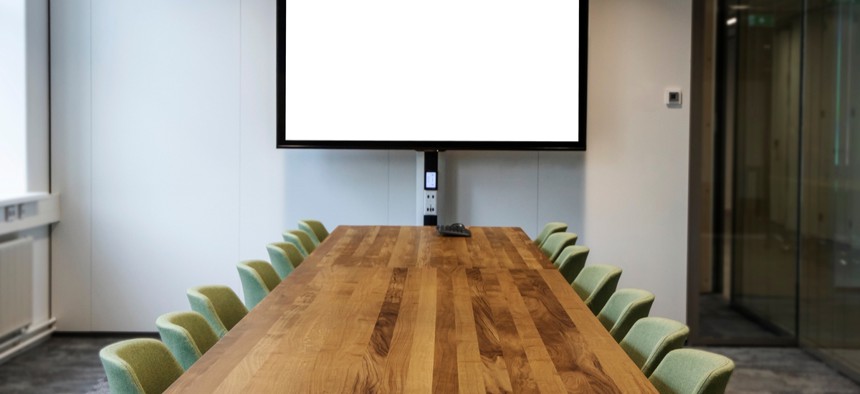In the Age of Social Distancing, Government Meetings Go Virtual

A handful of governors have loosened their states' open-meetings laws to temporarily do away with provisions that require boards and commissions to meet in person. Shutterstock
State and local governments are holding virtual meetings to slow the spread of Covid-19 and trying to find ways to continue public participation.
City council members in Worcester, Massachusetts on Tuesday gathered for their regular weekly meeting, with one new rule in place: No members of the public would be allowed to attend and if residents wished to make comments, they’d need to do so by calling into a teleconference line.
“It worked OK. It wasn’t perfect,” said Eric Batista, director of the city’s Office of Urban Innovation on Wednesday. “We’re debriefing today to kind of talk through about how it went. We’re doing everything we can to make sure it’s cleaner for the residents, and to make sure they always have an opportunity to engage and comment and be part of the process.”
The move, a precautionary measure to help limit the spread of Covid-19, is permitted under an executive order issued last week by Gov. Charlie Baker that suspends a requirement in the state’s open meetings law that governmental bodies meet physically in a public space. When possible, officials are required to provide “alternate means” of public access, such as teleconferencing or live-streaming. If that’s not possible, boards must post a full transcript, video or recording of meetings online “as soon as practicable upon conclusion of the proceedings.”
These kind of virtual meetings are an increasingly popular option for state and local government boards and commissions as the coronavirus continues to spread through communities. Some states, such as Massachusetts, Louisiana, Texas and Nebraska, have loosened open meetings laws to allow boards and committees to meet remotely, measures that lawmakers have said are necessary to comply with federal recommendations that even small gatherings be suspended in the interest of public health.
“The executive order is part of an overall public health strategy to increase social distancing to stem the spread of the coronavirus disease,” Nebraska Gov. Pete Ricketts said in a statement.
The state-level proclamations do away with mandates for physical quorums but maintain other basic tenets of open meetings laws, including requirements that governments publicize meeting dates and make agendas available ahead of time. The orders also require that members of the public are allowed to participate and, when possible, address the board during telephone or video-conference meetings.
Under normal circumstances, the rules would be cause for concern. But these are not normal circumstances, said Scott Sternberg, a New Orleans-based media lawyer.
“As somebody with young children and elderly parents and a pregnant wife, I recognize completely the need for people to stay away from each other right now. And that doesn’t really jive with public meetings, where the whole idea is that you’re able to be there,” he said. “But it’s no longer safe to have 50 people in the same room, so how do we have a school board meeting if it’s not safe and medical professionals are telling us that it’s not safe? This is a situation that is completely unprecedented and I have no idea how to deal with it other than to say that the public bodies that are using virtual meetings to make sure that the public is informed are doing the right thing.”
Aside from the broad parameters outlined in executive orders, municipalities have largely been left on their own to figure out the specifics of guaranteeing public access to virtual meetings.
In Worcester, officials opted to use a teleconferencing system that allows multiple users to phone in to the same meeting. The system did allow residents to participate in the city council’s meeting, Batista said, but posed certain technical issues. For example, the program numbers callers rather than identifying them by name, which made it difficult for councilors to know which resident was speaking on which issue.
“We eventually just had to unmute everybody and treat it as a conference call where everyone just kind of talks,” he said. “We were lucky enough that people introduced themselves and said what they were there to speak on, but we know that’s not the best scenario, so we’re kind of debriefing on our end and exploring other options.”
That type of trial and error could prove useful to cities, Sternberg said, both now and after the pandemic is over.
“As the crisis continues, and we keep getting reports of what different cities are doing, what we’re seeing almost universally is that the right to attend a meeting is going virtual,” he said. “Things will eventually go back to normal, but I feel like as municipalities are considering these things they didn’t think they needed to consider before, we may see participation even increase in the future now that we’ve explored these options.”
Kate Elizabeth Queram is a Staff Correspondent for Route Fifty and is based in Washington, D.C.
NEXT STORY: Trump Signs Coronavirus Aid Bill to Expand Sick Leave, Free Testing





